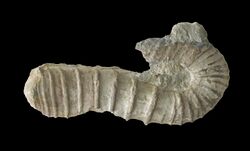Biology:Hamulina
| Hamulina | |
|---|---|

| |
| Hamulina astieri | |
| Scientific classification | |
| Domain: | Eukaryota |
| Kingdom: | Animalia |
| Phylum: | Mollusca |
| Class: | Cephalopoda |
| Subclass: | †Ammonoidea |
| Order: | †Ammonitida |
| Suborder: | †Ancyloceratina |
| Family: | †Hamulinidae |
| Genus: | †Hamulina d'Orbigny, 1850 |
Hamulina is an extinct ammonoid cephalopod genus belonging to the family Hamulinidae.[1] These cephalopod were fast-moving nektonic carnivores. They lived during the Cretaceous period, Barremian age. The type species is Hamulina astieriana.
Description
It may be large. The whorl section generally is increasing rapidly. The short final shaft is generally straight or curved. The main shaft is with dense, fine, prorsiradiate minor ribs and distant, periodic, weakly trituberculate major ribs. The minor ribs are weakened or disappearing on hook and final shaft. The major ribs are strengthened and approximating. The ammonitic suture is finely divided.
Distribution
Fossils of these cephalopods have been found in rocks of Cretaceous of Bulgaria, Colombia (Santa Rosa de Viterbo, Boyacá), Hungary, Italy, Mexico, Spain , Trinidad and Tobago.[2]
Hamulina astieri from southern Alps, on display at Galerie de paléontologie et d'anatomie comparée, Paris
Hamulina pamuktschiensis sp.n., Lower Barremian, Pamuktschii at the Sofia University Museum of Paleontology and Historical Geology
References
- ↑ Wright, C. W. with Callomon, J.H. and Howarth, M.K. (1996), Mollusca 4 Revised , Cretaceous Ammonoidea, vol. 4, in Treatise on Invertebrate Paleontology, Part L (Roger L. Kaesler ed.), Boulder, Colorado: The Geological Society of America & Lawrence, Kansas: University of Kansas Press, pp. 231, 232.
- ↑ "Hamulina". Fossilworks. http://www.fossilworks.org/cgi-bin/bridge.pl?action=taxonInfo&taxon_no=14549. Retrieved 2 May 2022.
Further reading
- "Hamulina". mindat.org. https://www.mindat.org/taxon-4626462.html. Retrieved 2 May 2022.
- Wright C.W. with J.H. Callomon and M.K. Howarth (1996). "Mollusca 4 Revised: Cretaceous Ammonoidea". in Roger L. Kaesler. Treatise on Invertebrate Paleontology Part L. 4. Boulder, Colorado and Lawrence, Kansas: The Geological Society of America & University of Kansas Press. p. 231-232. https://archive.org/details/treatiseoninvert0000join/page/n3/mode/2up?view=theater.
- Arkell, W. J.; Furnish, W. M.; Kummel, Bernhard; Miller, A.K.; Moore, R.C.; Schindewolf, O.H. (1957). "Part L, Mollusca 4: Cephalopoda, Ammonoidea". in Raymond C. Moore. Treatise on Invertebrate Paleontology. Geological Society of America and University of Kansas Press. p. L215. https://archive.org/details/treatiseoninvert0000unse_n4o3/page/n3/mode/2up?view=theater.
- Sepkoski, Jack Online Genus Database – Cephalopodes
Wikidata ☰ Q12258876 entry
 |



